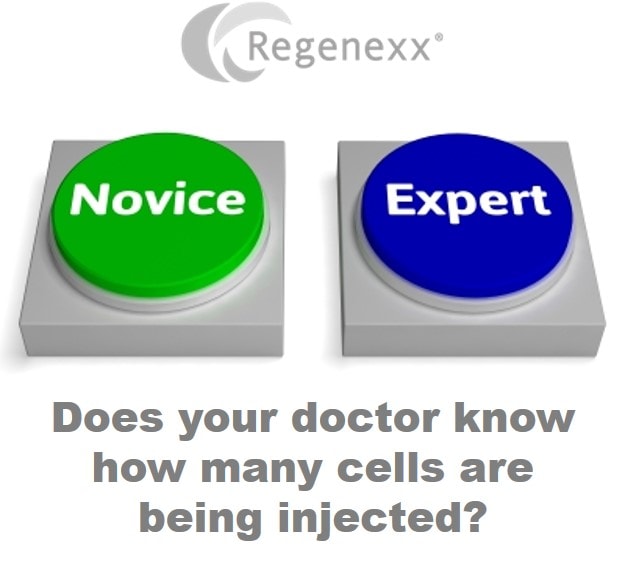Stem Cell Novice vs. Stem Cell Expert: Knowing What’s Injected…
Is your doctor an expert at stem cell therapy, or a novice? How would you know? Earlier this week I wrote about a simple question regarding a bone marrow aspiration that you could ask to tell the difference. This morning I have another question for you to ask your doctor – does he or she have any idea how many cells are being injected? A stem cell expert counts the number of cells, while a novice blindly injects whatever the simple bedside centrifuge supplies. Let me explain.
When we began performing stem cell orthopedic procedures in 2005, we were focused on cultured and same day procedures. Counting the cell number just made sense, otherwise, how would you have any idea of dose? Fast forward a decade and now that many physicians have jumped on the bandwagon, the idea of knowing how much of what’s being injected has gone out the window. Why? The simple bedside machines being used by these physicians can’t determine dose. In addition, not having a dose number factors into another critical aspect of a stem cell procedure, avoiding things that kill the dose like clots in the sample and also drawing from many sites versus one.
As I relayed in the last post, the wheels came off of the proverbial bus when bedside machine manufacturers hired non-experts to teach physicians how to perform the mechanics of a stem cell procedure which includes the bone marrow aspiration and then re-injection. These non-experts had never had to be responsible for knowing stem cell dose, because without a lab, they had no way to measure it. This causes all sorts of issues, like having no way to tell if the method you’re using to draw cells is good or bad, because you don’t know the end result (i.e. if I do it this way I almost always get more cells than if I do it that way). Hence these doctors took short-cuts that made the procedure easier for them personally, sacrificing yield. Another problem caused by using these simple bedside machines is that neither the doctor nor the medical assistant placing the sample in the machine and pushing the “ON” button ever interacted with the sample. This also lead to another problem – yield destroying clots.
Bone marrow contains many platelets and all of the stuff needed to form a really tough clot. If the doctor’s lab is measuring the number of cells and interacting with the sample, it’s fairly easy to see if parts of the sample are clotted. When this happens, the stem cells and other important cells are irreversibly lost in the clot and can’t be retrieved, reducing the final dose of cells re-injected into the patient. Hence a stem cell expert does many things to avoid clots. First, many of the simple bedside machines use a anti-coagulant known as ACD, which regrettably allows more clots to form in some patients. So a stem cell expert uses Heparin in the correct dose to reduce clots. Second, since a novice is oblivious to cell number and clots, he doesn’t pre-heparinize each draw site to further prevent clots, while an expert knows that this is an essential step to protect the integrity of the sample being drawn.
The upshot? Experts who perform same day stem cell treatments understand that learning how to accurately use a cell counter to determine the number of cells being injected is key. Having this data allows the doctor to not only dose a joint or other area correctly, but also informs the doctor on whether his stem cell draw technique was good or poor. Non-experts teaching novice physicians have lead to a world where the physicians charging big bucks for these procedures don’t know what they don’t know. One of those things they don’t know is whether there are clots in the sample robbing the patient of valuable stem cell numbers or whether their single site harvest technique is artificially reducing stem cell number. So what simple question can you ask the doctor to see if he’s a novice or an expert? Ask him/her or the staff whether the doctor has the ability to count the number of cells being injected in the office and if you will be provided with that exact number at the time of re-injection. If the answer is no, then you’re seeing a novice and not an expert, so you may want to find another doctor to perform this procedure!

If you have questions or comments about this blog post, please email us at [email protected]
NOTE: This blog post provides general information to help the reader better understand regenerative medicine, musculoskeletal health, and related subjects. All content provided in this blog, website, or any linked materials, including text, graphics, images, patient profiles, outcomes, and information, are not intended and should not be considered or used as a substitute for medical advice, diagnosis, or treatment. Please always consult with a professional and certified healthcare provider to discuss if a treatment is right for you.

